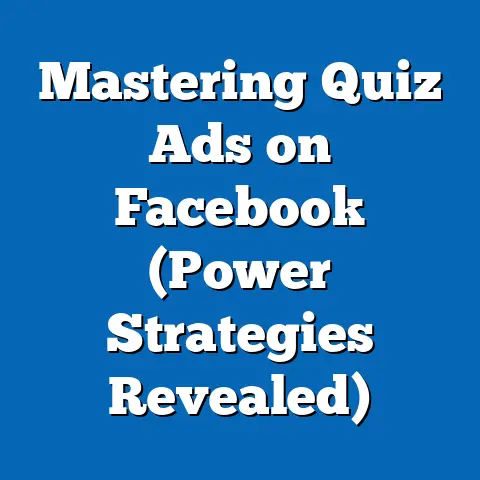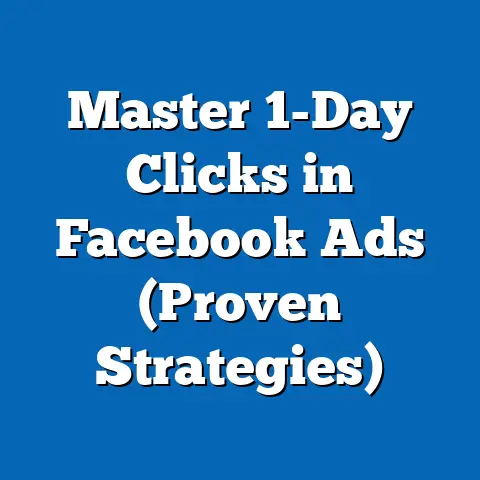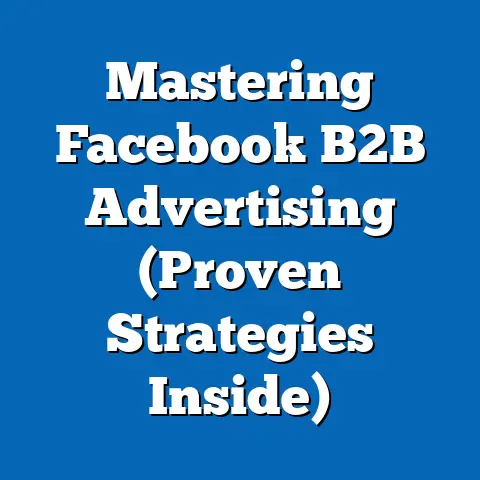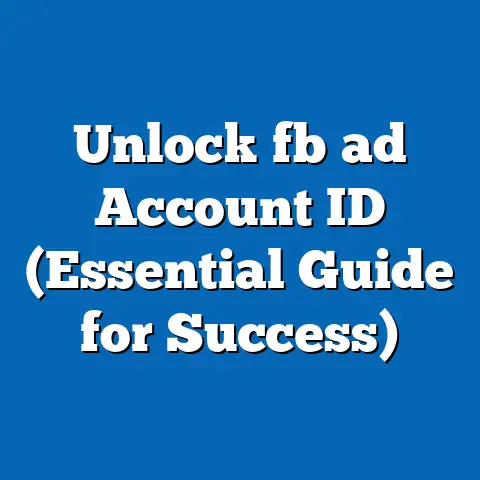Mastering iOS 14 Changes in Facebook Ads (Critical Insights)
When Apple rolled out iOS 14, it felt like the marketing world collectively gasped. It was like showing up to a party only to realize you’re wearing the wrong outfit, or, perhaps more accurately, like trying to find your way home after a particularly spirited night out, only to discover your GPS has decided to take an impromptu vacation. Suddenly, everything we thought we knew about Facebook advertising felt… different.
I remember sitting at my desk, staring at campaign dashboards that were suddenly displaying numbers that made absolutely no sense. Conversion rates were down, retargeting was a mess, and it felt like I was trying to navigate a maze blindfolded. But hey, that’s marketing, right? We adapt, we evolve, and we find new ways to make things work.
Overview of iOS 14 Changes
So, what exactly happened with iOS 14? In a nutshell, Apple introduced a new feature called App Tracking Transparency (ATT). This feature requires apps to ask users for permission to track them across other companies’ apps and websites. Before iOS 14, this tracking was largely automatic. Now, users get a prompt that asks them, “Allow [App Name] to track your activity across other companies’ apps and websites?” with a big, friendly “Allow” or “Ask App Not to Track” button.
Here’s a breakdown of the critical changes:
- App Tracking Transparency (ATT): This is the big one. Users now have to actively opt-in to tracking.
- Aggregated Event Measurement (AEM): Facebook’s response to ATT, allowing for limited conversion tracking while respecting user privacy.
- Delayed Reporting: Data isn’t real-time anymore. Expect a delay of up to 72 hours.
- Limited Attribution Windows: The default attribution window changed from 28-day click and 1-day view to 7-day click and 1-day view.
- Domain Verification: You need to verify your domain in Facebook Business Manager to prioritize conversion events.
These changes directly impact Facebook because their advertising model relies heavily on tracking user behavior to deliver targeted ads and measure campaign performance.
Takeaway: iOS 14 put the user in control of their data, which means marketers need to be smarter and more respectful in how they collect and use information.
The Impact on Facebook Ads
The impact of iOS 14 on Facebook Ads has been significant, to say the least. It’s like suddenly trying to drive a race car with a flat tire. Here’s how it’s affecting different aspects of Facebook advertising:
- Ad Targeting: With fewer users opting in to tracking, audience sizes have shrunk, and the accuracy of interest-based targeting has decreased. This means your ads might not be reaching the most relevant people.
- Audience Segmentation: Retargeting, a powerful tool for reaching users who have already interacted with your brand, has become more challenging. Creating custom audiences based on website traffic or app activity is less effective when a significant portion of users are opting out of tracking.
- Measurement Accuracy: The biggest challenge is the reduced visibility into conversions. With delayed reporting and limited attribution windows, it’s harder to accurately measure the ROI of your Facebook ad campaigns. This makes it difficult to optimize your campaigns effectively.
I’ve seen firsthand how these changes have affected campaign results. For example, one of my e-commerce clients saw a 30% drop in conversion rates after iOS 14 was rolled out. The cost per acquisition (CPA) also increased significantly, making it harder to justify their ad spend.
Real-World Example:
One of my clients, a small business selling handmade jewelry, relied heavily on retargeting ads to drive sales. Before iOS 14, they could easily retarget users who had viewed specific products on their website. After the changes, their retargeting audience size plummeted, and their retargeting ads became much less effective. They had to rethink their entire advertising strategy.
Specific Challenges Advertisers Face:
- Reduced Audience Reach: Smaller audience sizes mean your ads might not be reaching as many potential customers.
- Difficulties in Retargeting: Retargeting is less effective when users opt out of tracking.
- Inaccurate Conversion Tracking: It’s harder to accurately measure the ROI of your campaigns.
- Increased CPA: The cost per acquisition has increased for many advertisers.
Takeaway: The iOS 14 changes have made Facebook advertising more challenging, but not impossible. The key is to adapt your strategies and leverage the tools and techniques available to you.
Adapting to the New Normal
So, how do we navigate this new landscape? The key is to adapt and embrace new strategies. Here are some insights into how you can adapt to the new normal created by iOS 14:
- Embrace First-Party Data: First-party data is information you collect directly from your customers, such as email addresses, purchase history, and website activity. This data is not affected by the iOS 14 changes and can be incredibly valuable for targeting and personalization.
- Leverage Customer Relationships: Focus on building strong relationships with your customers. Encourage them to sign up for your email list, follow you on social media, and engage with your brand. The more you know about your customers, the better you can target them with relevant ads.
- Contextual Advertising: Contextual advertising involves targeting ads based on the content of the websites or apps users are visiting. This approach doesn’t rely on tracking individual user behavior and can be a privacy-friendly alternative to traditional targeting methods.
- Build Brand Loyalty: Brand loyalty is more important than ever. When customers trust your brand, they’re more likely to engage with your ads and make purchases. Focus on providing excellent customer service, creating high-quality products, and building a strong brand reputation.
Examples of Brands That Have Successfully Pivoted:
- Everlane: The clothing brand Everlane has focused on building a strong email list and using email marketing to reach their customers. They also prioritize creating high-quality products and providing excellent customer service to build brand loyalty.
- Warby Parker: The eyewear company Warby Parker has focused on building a strong online community and using social media to engage with their customers. They also offer a home try-on program that allows customers to try on glasses before they buy them, which helps build trust and loyalty.
- Casper: The mattress company Casper has focused on creating high-quality products and providing excellent customer service. They also offer a 100-night risk-free trial, which allows customers to try out their mattresses before they commit to buying them.
My Personal Experience:
I worked with a local restaurant that was struggling to adapt to the iOS 14 changes. They had relied heavily on Facebook ads to drive traffic to their website and generate online orders. After the changes, their ad performance plummeted.
I helped them develop a new strategy that focused on building their email list and using email marketing to reach their customers. We also created a loyalty program that rewarded customers for making repeat purchases. Within a few months, their online orders had rebounded, and they were back on track.
Takeaway: Adapting to the new normal requires a shift in mindset. Focus on building relationships with your customers, leveraging first-party data, and exploring alternative targeting methods.
Innovative Tools and Features
Facebook hasn’t been sitting idly by while the world changes. They’ve rolled out several innovative tools and features to help advertisers navigate the iOS 14 changes. Here are some of the most important ones:
- Aggregated Event Measurement (AEM): AEM allows advertisers to prioritize conversion events and measure them in a privacy-safe way. It aggregates data from multiple users and reports it in a way that doesn’t identify individual users.
- Conversion API (CAPI): CAPI allows you to send conversion data directly from your server to Facebook, bypassing the limitations of browser-based tracking. This can help improve the accuracy of your conversion tracking.
- Facebook Pixel Helper: This Chrome extension helps you troubleshoot your Facebook Pixel and ensure it’s firing correctly. It can also help you identify any issues with your conversion tracking.
How to Use These Tools to Optimize Your Campaigns:
- Prioritize Conversion Events: In AEM, you can prioritize up to eight conversion events. Make sure to prioritize the events that are most important to your business.
- Implement CAPI: If you’re not already using CAPI, now is the time to implement it. It can help improve the accuracy of your conversion tracking and give you a more complete picture of your campaign performance.
- Troubleshoot Your Pixel: Use the Facebook Pixel Helper to troubleshoot your Pixel and ensure it’s firing correctly. This can help you identify any issues with your conversion tracking.
Screenshot Example (Ideally, a screenshot of the Facebook Ads Manager interface showing the AEM setup):
(Imagine a screenshot here showing the Facebook Ads Manager interface with the Aggregated Event Measurement settings highlighted. It would show where to prioritize conversion events and how to verify your domain.)
Takeaway: Facebook is providing advertisers with the tools they need to navigate the iOS 14 changes. The key is to understand how these tools work and use them effectively.
The Future of Facebook Ads in a Post-iOS 14 World
So, what does the future hold for Facebook Ads? It’s hard to say for sure, but here are some potential trends that may emerge:
- More Transparent Advertising Practices: As users become more aware of privacy issues, they’ll demand more transparency from advertisers. This means advertisers will need to be more upfront about how they collect and use data.
- Increasing Value of Privacy-Compliant Data Collection Methods: As privacy regulations become stricter, the value of privacy-compliant data collection methods will increase. This includes techniques like zero-party data collection, where users willingly provide information to brands.
- Greater Emphasis on Contextual Advertising: As mentioned earlier, contextual advertising is a privacy-friendly alternative to traditional targeting methods. We may see a greater emphasis on this approach in the future.
- Personalized Ads: The rise of AI will allow for more personalized ads, with better ROI and less need for extensive data tracking.
How to Future-Proof Your Strategies:
- Invest in First-Party Data: Build a strong email list and encourage customers to share their data with you.
- Explore Alternative Targeting Methods: Experiment with contextual advertising and other privacy-friendly targeting methods.
- Stay Up-to-Date on Privacy Regulations: Keep an eye on changes in privacy regulations and adapt your strategies accordingly.
- Focus on Building Brand Loyalty: When customers trust your brand, they’re more likely to engage with your ads and make purchases.
Takeaway: The future of Facebook Ads will be shaped by privacy concerns and regulatory changes. The key is to stay informed, adapt your strategies, and prioritize user privacy.
Conclusion: Wrapping it Up with a Smile
Well, there you have it. Navigating the iOS 14 changes in Facebook Ads has been like trying to herd cats, but hopefully, this guide has provided you with some valuable insights. Remember that while the iOS 14 changes may feel overwhelming, they also present unique opportunities for creativity and innovation in advertising.
Think of it like this: You’re a chameleon in the marketing jungle, and you need to change your colors to fit in with your surroundings. Embrace the challenge, adapt your strategies, and remember to keep a sense of humor. After all, if we can’t laugh at the chaos, what can we do?
Now go out there and conquer the world of Facebook Ads, one privacy-compliant ad at a time! Good luck!






